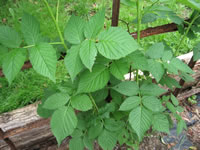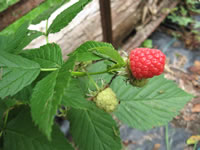|
Planting Raspberries
Raspberries come in four colors, red, yellow, purple and black.
The purple and black varieties have rigid, upright stems and are able to stand alone.
Red and yellow varieties are trailing plants that should be supported on wires or a trellis.
It is a good idea to add this support before planting your Raspberries.
The preferred method is to string heavy gauge wire between stout posts,
with the bottom wire 30" above ground and a top wire at 4-5 feet.
The lateral side branches of the Raspberry plant can then be trained along the wires.
Raspberries can be planted any time from late fall up until early spring before new growth begins.
They should be planted 30"-36" apart in rows that are spaced 8 feet apart.
Plant nursery grown Raspberry plants in a prepared bed, 2" deeper than they were originally growing.
After planting, cut the canes back to 4-6", leaving the stubs to mark the rows until new sprouts appear.
Pruning Established Raspberry Plants
Raspberry plants produce their fruit on canes that sprouted during the previous year.
Newly planted summer bearing Raspberries should be left alone for the first year to establish themselves.
After fruiting, the canes should be cut back to the ground, after which,
new second year canes will begin to develop around the crown of the plant.
Remove all but the strongest 7-10 canes and attach the remaining canes to the top wire.
Before new growth begins in the following spring, cut the canes back to 5 feet to induce lateral branching.
|
Everbearing Raspberries require a slightly different method of pruning.
They will produce fruit on the top 1/3 of the plant during their first fall.
After fruiting, remove the portion of the plant that produced berries, but let the lower 2/3 of the plant remain to produce next spring's crop.
Remove the canes completely after they have fruited over their entire length.
New canes will quickly emerge to replace the spent ones.
Never cut off the new canes that haven't produced yet,
they will produce the next years crop.
Purple Raspberries and Blackcap Raspberries should be pinched back
when they reach 2 ft. tall in order to promote lateral growth.
Cut the laterals back to 12" during the winter. |
|
Propagating Raspberry Plants
Raspberry plants can be easily propagated in late summer by tip layering the current season's growth.
By late August new canes will begin to arch down in an effort to self-propagate.
As the tips of the cane touch the soil, they will often take root and begin to grow upward without assistance.
If you prefer to take on the process yourself, simple bury the tips of arching canes about 3" deep.
The tips root quickly this way.
It is possible to transplant the new plantlets as soon as new growth begins, but for better results
allow the plantlet to remain undisturbed until early in the next spring, before new growth begins.
Raspberries can also be propagated by digging and replanting sucker growths that sprout up away from the parent plant.
Raspberry
Rubus idaeus
 |
 |
Summer Bearing Raspberries
Puyallup (Zones 4-8) Large berries produced mid summer
Willamette (Zones 5-8) Large, dark berries mid season
New Washington (Zones 3-9) Small but very tasty berries
Latham (Zones 4-8) Berries tend to be crumbly and prone toward mildew
Meeker (Zones 4-8) Large fruit, pretty plants
Canby (Zones 5-8) Very large red berries
Boyne (Zones 3-9) One of the earliest producers
|
Everbearing Raspberries
Heritage (Zones 4-7) Bears in June and again in September
Fallred (Zones 4-7) Bears in June and again in mid fall
Durham (Zones 4-7) Primarily a fall bearer, medium berries
Indian Summer (Zones 4-7) Small crops, but huge berries. Fall crop tends to be more productive
September (Zones 4-7) Small berries produced in June but primarily a fall bearer
Bababerry (Zones 4-7) Bears in spring and fall. Must have cold winters)
|
|


